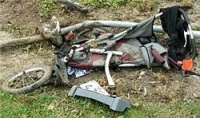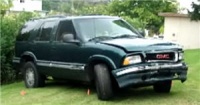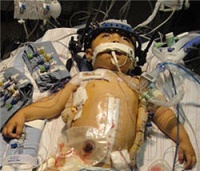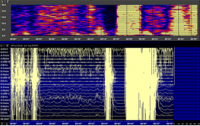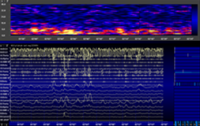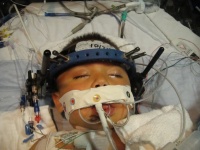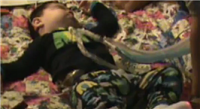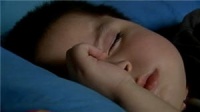Child hit by drunk driver while his grandfather was pushing him in his stroller on walking on sidewalk
A drunk teenager leaving the park he had been bingeing overnight jumped the curb running over Baby Izaiah. (Note the vehicle he was driving and the condition of the stroller Baby Izaiah was riding in above) Paramedics told me they didn't know if Izaiah was dead or now when they picked him up and rushed him to the hospital. One of the paramedics told me he couldn't wait to get home to simply love on his kids and know they were safe.
Thank God for great paramedics and the doctors at Rady Children's Hospital who saved Izaiah’s life.
Izaiah’s grandmother said in a letter that “While in the hospital we were told by a team of doctors that Izaiah was severely brain damaged and that he should be sent home on hospice, basically to die.”
I was contacted by a charity asking if we could help. I didn't know Izaiah’s condition but told the charity we would do all we could possibly do. My job is to provide new tools and pathways the doctors can use when they run out of options.
At our first contact with the family of Baby Izaiah we were told they didn't know if he had vision and if he did they didn't know to what degree.
The brain is an amazing tool and very malleable. My greatest challenge would be the neural connections. A neural assignment (in this case vision) without connections is incomplete.
When you consider this child had just been ran over by a large SUV, thrown from his stroller then through a series of surgeries, mountains of pharmaceuticals, muscle relaxers and other elixir's, being poked, drips, tubes and being confined causes total body stress.
Stress can literally change the shape and size of the brain and the visual cortex runs front to back in the brain.
I did brain imaging on Baby Izaiah and saw copious amounts of stress, greater than what I normally see with Post Traumatic Stress Disorder (PTSD).
My challenge was to ease the stress activity in the areas defined in the image - 1 to the left.
Within a few minutes, we noticed Izaiah’s eyes were tracking the Finding Nemo video. Everyone in the room started crying, clapping and hugging when they noticed the first of several exciting moments. See Image 2 on the left to notice the difference the BRE protocol made.
I ran this protocol for Baby Izaiah and achieved the following results in about twenty minutes. This is not typical as the time varies person to person. Everyone’s brain is as unique to them as their fingerprints and seldom is a traumatic brain injury similar to another. Image 2 on the left will show you the difference
I then looked at the challenges causing the paralysis. Paralysis can have many gateways. Therefore, I look as the areas that send emergency signals throughout the body when it is challenged by a traumatic event.
While this is not meant to be a lesson in anatomy, it is to guide you on my thought process when I was working with Baby Izaiah and, please understand I am NOT a medical doctor. I develop signals that relax, excite, inhibit or reroute information. When I do, we have seen exciting things happen.
The sympathetic nervous system prepares the body for emergencies and the parasympathetic restores the organism to its normal function. What happened is Izaiah had experienced a traumatic event but the system was not restored to its normal function. He remained paralyzed and his vision was challenged.
I knew the spinal cord was going to be challenged therefore I my work would be challenging. Knowing Izaiah had the best of care at Rady’s, knowing they took him as far as medical science would allow. My challenge was to find any scrap of useful neural connections I could use to attempt to make connections.
The technology is called Behavioral Relationship Entrainment. It is a non invasive, totally relaxing protocol in which I embed special signals in soothing music to achieve results. I have on many occasions used signals without music but the clients and patients seem to relax more when I embed the signals in music.
Many clients will fly into San Diego to have this protocol before they go into surgery. They claim (as have their doctors) there is less bleeding, less swelling and a faster recovery.
Notice the position of his legs when he we received him in image 3. Instead of straight, they were in the shape of an upside down “U”.
At that time, I was also looking closely at the cerebellum and the central motor cortex as well as the brain stem.
When I am working with an infant, the infant cannot tell me where it hurts so I have to follow body language (NLP) through movement, sound or position. Izaiah’s breathing was quite challenged and his legs were in a position as described previously.
Again, turning to the BRE program, we started seeing new cognitive abilities such as him reaching and rolling over as shown in the photo to the left.
The next steps were to take the pressure off the brain by mapping the skull.
When you work with someone with brain injury caused by skull impact, I look for the position of the sutures and their relation with those around them.
You can see where the plates were jammed in the image to the left. I found the occipital bone was overlapping the posterior parietal bone. The sphenoid bone seemed pushed in.
I needed a method of moving the skull bones which bring great relief to the nervous system as well as the spinal cord. I found a doctor who had a device that would gingerly move the plates to their correct location. The challenge is when you move one bone, it has a direct effect on those around it. It had to be done in such as way as not to cause additional damage.
Moving the plates was a ginger move by Dr. Steve and not a pleasant experience for Izaiah but I monitored his stress levels in each location as Dr. Steve gently moved the skull bones back in place.
I had constant contact with Dr. Steve so we could watch Izaiah’s activity levels in the areas we were working with increase, decrease or remain.
Within minutes, both legs were straight as noted in the picture to the left.
I continue to update Izaiah’s protocols as the doctors and therapists work with him.
I received the sweetest letter from Izaiah’s grandmother and with her permission, I have included it on the next page.
You can watch a video of Izaiah’s father Jacob and his grandmother Maria on the web site by clicking on the ‘Link to Video’ button to the left.
The following is a letter from Baby Izaiah's grandmother.
Hello, I am Izaiah's grandmother.
Dr. Maness is truly a gift from heaven. His work on my grandson has been more than a miracle. I have literally been an eyewitness to the remarkable improvement that my grandson has made while under the care of Dr. Maness.
If you could see how great Izaiah is doing now, you would be brought to tears.
Izaiah would constantly cry with fear, he would not let anyone touch him, not even his own parents! Izaiah is now showing a huge improvement, he is a happier little boy. He is starting to communicate with us by making verbal noises until he gets our attention. He smiles and claps with so much joy when we respond. You have no idea how happy it makes me feel now that Izaiah has said his first word since his accident. He now says ”Yay” and claps his hands at the same time.
He bends his body forward and pushes himself back up to a sitting position, holds on to his bedrails and moves around so much in his bed that we have to keep a close eye on him to make sure he doesn't fall out!
Mind you, this is the same little boy they said had irreversible brain damage!!
Dr. Maness is a good-hearted man who helps people get better and enjoy the life they deserve to live.
Thank you - MG








